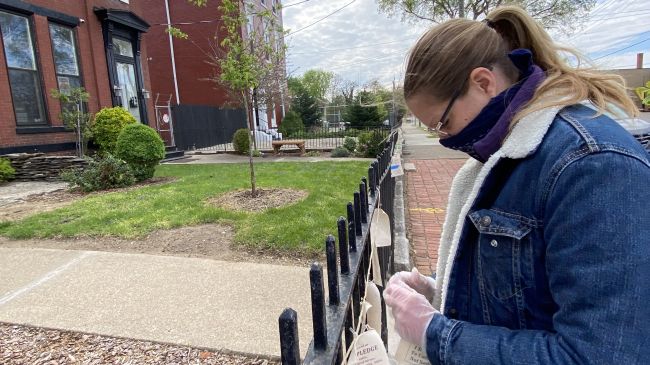
By Steven Krolak
(NEW ALBANY, Ind.)–Susanna Crum, assistant professor of fine arts and her partner, Rudy Salgado, are blending art, reminiscence and a sense of place to boost morale in Louisville, Kentucky.
Crum and Salgado are reproducing and distributing a found artifact: pledge badges from the Great Flood of 1937.
Printed on camvas and pinned to a line in front of the couple’s studio, Calliope Arts, in the Smoketown neighborhood, the badges recall the resilience of past generations of Louisvillians to inspire the city’s inhabitants of today, who are coping with the global coronavirus pandemic.
For Crum, a Louisville native whose work reframes local history to inform the way we inhabit our lived spaces, the flood resonates far more vividly than the 1918 flu pandemic.
“My whole life I’ve heard about the 1937 flood as a significant test for Louisville and Southern Indiana residents,” Crum said. “I’ve seen flood maps and markers showing that floodwaters rose right up to our 135-year-old home and studio in Smoketown.”
In January, 1937 the rain-swollen Ohio River rose to 57 feet above flood stage, inundating large parts of Louisville, Jeffersonville, New Albany and Portland. According to the Filson Historical Society, roughly 60 percent of Louisville was flooded, and some 66 percent of the population had to be evacuated. Recovery was long and arduous. Many neighborhoods had to be rebuilt. Some were lost forever.

During the long recovery, Louisville Mayor Neville Miller created a Committee on Morale, which produced pledge badges to help residents stay positive and focus on helping one another.
The wearer pledged to be giving, unselfish and friendly, and to refrain from complaining and spreading bad news.
The final line was a rather unique exhortation: “I dare you to catch me not smiling.”
Crum first learned of the badges through a magazine article drawing attention to versions that had begun to appear on telephone poles in Louisville during the early days of the pandemic.
Crum translated the image to a format for screenprinting. Then she and Salgado printed several hundred badges by hand, and began attaching them to their front fence by safety pins.
Judging by how often Crum and Salgado have restocked the fence, the badges are catching on.

“We’ve loved seeing people come by to take packs or individual badges, and have even had socially-distant conversations with them from our third-floor windows,” Crum said. “Some people have left small handmade gifts and flowers in return.”
For Crum the artist, the experience recalls the days after the 9/11 attacks, when people flocked to museums, galleries, theater and concert halls in search of solace and community.
“Visual, literary, and performing arts offer a distraction during dark times, but they also provide a connection to other people, a release valve for emotions, and unique answers to questions that you might already have,” Crum said.
Crum sees in this project the ability of art and artists to provide continuity with the past, hope for the future, and an aesthetic experience to share (though remotely) with others.
“The badges connect us to Louisvillians who were doing the best with what they had, in a very different time,” Crum said. “It’s a reminder that communities get through things together.”


